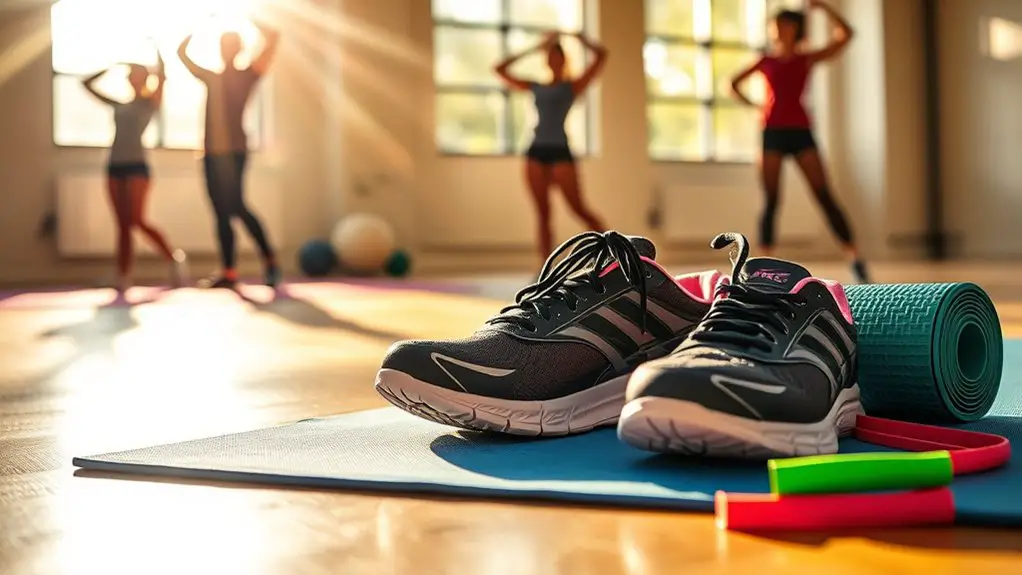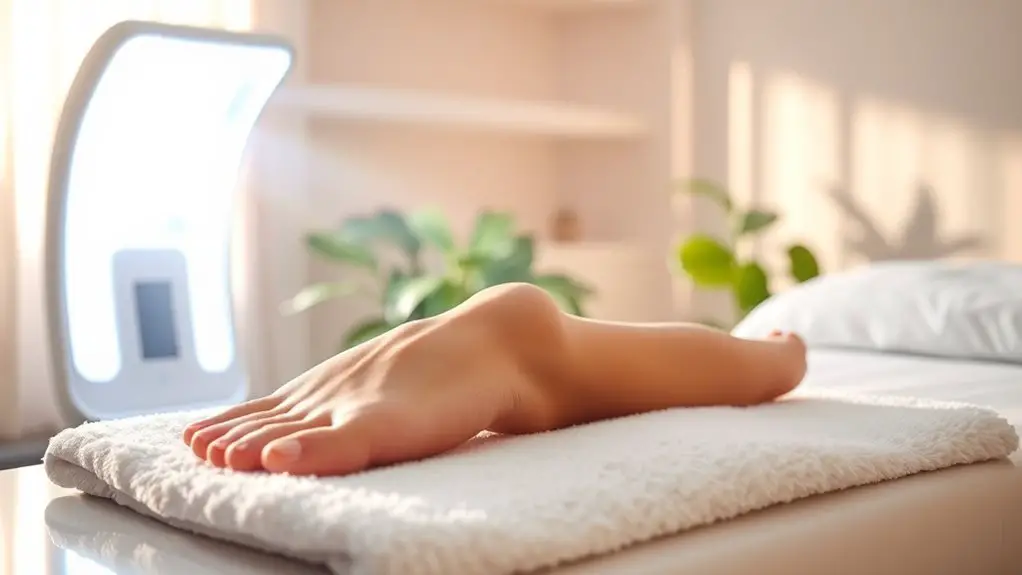Yes, athlete’s foot is indeed a fungal infection that usually affects the skin between your toes. It thrives in warm, damp environments, leading to symptoms like itching, burning, and peeling skin. While often associated with athletes, anyone can get it, especially in places like public showers or swimming pools. To better understand the causes, symptoms, and prevention methods, keep exploring the information available on this common condition.
Understanding Athlete’s Foot: What Is It?
Athlete’s foot is a common fungal infection that primarily affects the skin between your toes. It’s one of those pesky skin conditions that can really cramp your style. You might notice itching, burning, or even peeling skin, which can feel downright uncomfortable. This infection thrives in warm, damp environments, making it a frequent issue for those who enjoy freedom in sports or physical activities. While it’s often associated with athletes, anyone can experience this annoying fungal infection. Knowing what it is and how it behaves can empower you to take action. Remember, understanding this condition is the first step toward reclaiming your freedom and comfort. So, don’t let athlete’s foot hold you back; you’ve got the power to fight it!
Causes of Athlete’s Foot Fungus
Athlete’s foot fungus thrives in warm, moist environments, making your feet a prime target if you’re not careful. Poor foot hygiene can also contribute to the problem, as it allows the fungus to flourish. Additionally, direct skin contact with infected surfaces can easily spread the fungus to your feet.
Warm, Moist Environments
When it comes to athlete’s foot fungus, warm and moist environments play an essential role in its development. These conditions create a perfect breeding ground for fungi, making it important for you to manage moisture control. Think about places you frequent where warmth and humidity thrive.
| Environment | Risk Level |
|---|---|
| Public showers | High |
| Swimming pools | High |
| Gyms | Moderate |
| Wet footwear | High |
| Warm, closed spaces | Moderate |
Poor Foot Hygiene
Poor foot hygiene can greatly increase your risk of developing athlete’s foot fungus, especially if you neglect basic care practices. If you’re not washing your feet regularly or drying them properly, you’re inviting trouble. Remember, your feet deserve the same attention as the rest of your body. Good foot care isn’t just about looking good; it’s about feeling good too. Make it a habit to keep your feet clean and dry, especially between the toes. Change socks frequently, particularly after sweating, and choose breathable footwear. By establishing solid hygiene habits, you can greatly reduce your chances of infection. Embrace the freedom of healthy feet and let them thrive with the care they need!
Direct Skin Contact
Direct skin contact with infected surfaces is one of the most common ways to contract athlete’s foot fungus. This direct transmission can happen without you even realizing it. Here are some high-risk areas to watch out for:
- Public showers and pools: Perfect breeding grounds for fungi.
- Gym lockers: Often damp and crowded, increasing your risk.
- Shared footwear: Trying on shoes can lead to unwanted skin contact.
To enjoy your freedom, be mindful of where you step. Avoid walking barefoot in communal areas, and always wear flip-flops or water shoes. Remember, staying vigilant about direct skin contact can help keep that pesky fungus at bay. Your feet deserve some love and protection!
Common Symptoms to Watch For
When dealing with athlete’s foot fungus, you might notice several common symptoms. Itchy skin, redness, and inflammation are often the first signs to appear. Additionally, peeling or cracking skin can lead to further discomfort if not addressed promptly.
Itchy Skin Sensation
Although it might start as a minor annoyance, the itchy skin sensation associated with athlete’s foot can quickly become unbearable. You may find yourself constantly scratching, which only exacerbates the problem. To regain your comfort and freedom, keep an eye out for these symptoms:
- Persistent itching between the toes
- Dry, flaky skin that feels tight
- Intense urges to scratch, especially after taking off shoes
Finding effective itch relief is essential for your skin care routine. Moisturizers and antifungal creams can help soothe the irritation and combat the fungus causing the itch. Don’t let that itch control your life—take action and find the remedy that works for you!
Redness and Inflammation
As the athlete’s foot progresses, you might notice redness and inflammation around the affected areas, which can signal an escalating infection. This redness often results from the body’s immune response to the fungal invader. It’s essential to recognize these symptoms early, as they can lead to discomfort and further complications if ignored. Common redness causes include prolonged exposure to moisture and friction from footwear. For effective inflammation treatment, consider antifungal creams or over-the-counter remedies that target both the fungus and the inflammation. Keeping your feet dry and wearing breathable shoes can also help ease symptoms. Ultimately, staying vigilant and proactive will empower you to reclaim your freedom from this pesky condition. Take action before it worsens!
Peeling or Cracking Skin
Peeling or cracking skin often signals a more severe case of athlete’s foot, especially if left untreated. You might notice these peeling symptoms as your skin starts to lose its protective barrier, leading to discomfort and possible infection. Don’t ignore these signs; they indicate that the fungus is worsening.
- Red, inflamed patches may accompany the peeling.
- Itching and burning sensations can intensify with cracking skin.
- Blisters or open sores might develop if the condition progresses.
Risk Factors for Developing Athlete’s Foot
Several key risk factors can increase your chances of developing athlete’s foot, making it important to be aware of them. Genetic factors play a role; if you have a family history of fungal infections, you may be more susceptible. Your lifestyle choices also greatly impact your risk. For instance, spending a lot of time in damp environments, like pools or locker rooms, can expose you to the fungus. Wearing tight or non-breathable footwear traps moisture, creating an ideal breeding ground for the fungus. Additionally, poor hygiene habits, such as not drying your feet properly after washing, can increase your vulnerability. By understanding these risk factors, you can take proactive steps to protect yourself and enjoy your freedom from athlete’s foot.
Myths About Athlete’s Foot Explained
Understanding the risk factors associated with athlete’s foot can help you take preventive measures, but many misconceptions about the condition persist. Let’s clear up some common fungal misconceptions with a bit of myth debunking:
Understanding athlete’s foot risk factors is crucial, yet many myths about the condition still need clarification.
- Only athletes get athlete’s foot: Anyone exposed to damp environments can contract it.
- You can’t spread it: The fungus can live on surfaces, so it can easily spread to others.
- You don’t need treatment: Ignoring it can lead to more severe infections and complications.
Diagnosis: How Is Athlete’s Foot Identified?
How can you be sure if you have athlete’s foot? The first step is a visual diagnosis. You’ll want to look for common symptoms like redness, itching, and peeling skin between your toes. If you notice these signs, it’s time to take action. Sometimes, a simple visual inspection isn’t enough, and that’s where lab tests come into play. A healthcare professional might take a skin scraping to examine under a microscope or send it for culture tests to confirm the presence of fungus. Trust your instincts; if something feels off, don’t hesitate to seek professional advice. Remember, getting an accurate diagnosis is key to reclaiming your foot freedom and preventing further issues.
Treatment Options for Athlete’s Foot Fungus
Once you’ve confirmed you have athlete’s foot, it’s crucial to explore effective treatment options to alleviate your symptoms and eliminate the fungus. You can take charge of your health with various solutions available:
- Over the counter treatments: Antifungal creams, sprays, and powders can provide relief and tackle the infection.
- Prescription medications: If your athlete’s foot is persistent, a doctor might prescribe stronger antifungals to help eliminate the fungus effectively.
- Lifestyle changes: Keeping your feet dry and clean, wearing breathable footwear, and avoiding communal showers can help prevent recurrence.
Home Remedies: Can They Help?
While over-the-counter treatments and prescription medications are effective for athlete’s foot, many people also consider home remedies as a complementary approach. If you’re looking for natural treatments, you might find some herbal remedies helpful in alleviating symptoms.
| Remedy | Benefits | How to Use |
|---|---|---|
| Tea Tree Oil | Antifungal properties | Apply diluted oil directly to the affected area. |
| Garlic | Antimicrobial effects | Crush and apply garlic paste on the infection. |
| Vinegar | Balances pH levels | Soak feet in diluted vinegar for 30 minutes. |
| Coconut Oil | Moisturizing and healing | Apply directly to soothe and hydrate skin. |
These remedies can provide relief, but they shouldn’t replace professional care if symptoms persist. Enjoy exploring these options!
Prevention Tips to Avoid Athlete’s Foot
To prevent athlete’s foot, it’s vital to maintain proper foot hygiene and make smart choices about your footwear. Embrace freedom and comfort while keeping your feet healthy. Here are some essential tips to help you stay fungus-free:
- Choose moisture-wicking socks to keep your feet dry.
- Opt for breathable footwear choices that allow air circulation.
- Avoid walking barefoot in communal areas, like pools or locker rooms.
When to Seek Professional Help
If you’ve had athlete’s foot symptoms that persist for weeks, it might be time to see a professional. Severe pain or discomfort, or if the infection spreads to other areas, are also signs that warrant a visit to your doctor. Don’t ignore these warning signs; seeking help early can prevent further complications.
Persistent Symptoms Lasting Weeks
When symptoms of athlete’s foot linger for weeks, it’s essential to recognize the need for professional help. Ignoring chronic irritation can lead to complications, including fungal resistance that makes treatment more difficult. If you’re experiencing persistent issues, take action!
- Your skin’s not healing or getting worse.
- Over-the-counter treatments aren’t working.
- You notice additional symptoms, like redness or swelling.
Don’t let athlete’s foot control your life. Seeking professional guidance can provide you with the freedom to enjoy your activities without discomfort. A healthcare provider can offer tailored solutions, ensuring you get back on your feet—literally! Remember, addressing the problem sooner rather than later can prevent further complications and restore your well-being.
Severe Pain or Discomfort
Experiencing severe pain or discomfort from athlete’s foot can signal a more serious issue that needs professional attention. If you find that over-the-counter treatments aren’t providing relief, it’s essential to consult a healthcare provider. Severe symptoms might indicate a secondary infection or another underlying condition that requires specialized care. Don’t wait until the pain becomes unbearable; proactive pain management can make a significant difference in your healing process. Seeking help can also lead to effective discomfort relief strategies tailored to your needs. Remember, your body deserves the freedom to function without pain, and taking prompt action can help you regain that freedom and enjoy your daily activities once again.
Spreading to Other Areas
As athlete’s foot fungus spreads to other areas of your body, it’s essential to recognize the signs that indicate you should seek professional help. Ignoring these signs can lead to increased fungal transmission and compromised skin barriers, making it harder to treat.
- If you notice a rash or irritation on your hands or groin
- When the affected area becomes increasingly red, swollen, or painful
- If you experience persistent itching or discomfort that disrupts your daily life
Don’t let the fungus take control. Seeking timely medical intervention can help you regain your freedom from discomfort and prevent further spread. Remember, your skin deserves protection, so don’t hesitate to consult a healthcare professional if you notice these symptoms.
Frequently Asked Questions
Can Athlete’s Foot Spread to Other Parts of the Body?
An ounce of prevention’s worth a pound of cure. Yes, athlete’s foot can spread to other parts of your body, especially if you scratch the infected area and then touch other skin. You might notice athlete’s foot symptoms like itching or redness developing elsewhere, potentially leading to body part infections. Staying mindful and practicing good hygiene can help you keep it contained and enjoy your freedom from discomfort.
Is Athlete’s Foot Contagious to Other People?
Yes, athlete’s foot is contagious to other people. It spreads primarily through direct contact or by sharing contaminated surfaces, like floors or towels. To keep yourself and others safe, avoid walking barefoot in public places, wear flip-flops in communal showers, and don’t share personal items. Regularly washing your feet and keeping them dry can also help prevent transmission. Staying vigilant guarantees you maintain that freedom to enjoy activities without worry!
How Long Does Athlete’s Foot Typically Last?
“Time and tide wait for none.” Typically, athlete’s foot lasts from a few days to several weeks, depending on various duration factors like the severity of the infection and your overall health. To speed up recovery, keep your feet dry and clean, change socks regularly, and use antifungal treatments as directed. By following these recovery tips, you’ll regain your freedom to enjoy life without the discomfort of athlete’s foot weighing you down.
Can Pets Contract Athlete’s Foot Fungus?
No, pets can’t contract athlete’s foot fungus. While they can get their own fungal infections, the specific fungus that causes athlete’s foot primarily affects humans. However, it’s essential to maintain good pet health and hygiene to prevent any fungal issues in your furry friends. If you notice any unusual symptoms in your pet, like itching or skin changes, it’s best to consult your vet for advice and proper care.
What Footwear Is Best to Prevent Athlete’s Foot?
You want to feel free and comfortable, but wearing the wrong shoes can trap moisture and lead to issues. Opt for footwear made from breathable materials like mesh or leather, as they allow air circulation and help with moisture control. Avoid rubber or plastic shoes that can suffocate your feet. Remember, keeping your feet dry and cool is key to maintaining that freedom you crave while staying healthy!




